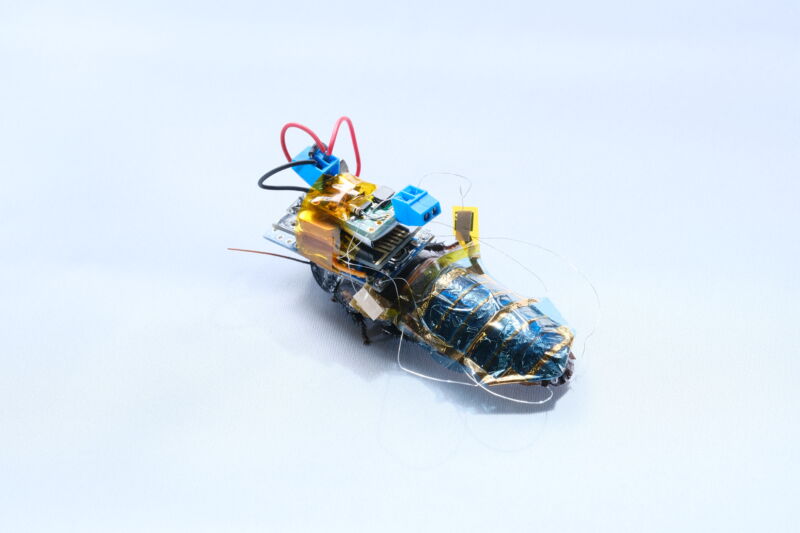Have you ever thought you’d be seeing a cyborg cockroach that runs on solar power and carries a backpack that looks like an electric circuit? A team of researchers at Japan’s RIKEN research institute has turned a regular Madagascar hissing cockroach into a real cyborg insect by connecting a lithium battery, a solar cell, multiple wires, and a tiny electronic circuit. The cyborg can be controlled using Bluetooth signals, and the researchers suggest that, in the future, such robo-bugs could be employed for search-and-rescue missions.
The researchers refer to their cyborg as an insect-computer hybrid system, and it incorporates a living insect as a platform and a mini-electronic system as its controller. Basically, it’s a biobot that can be controlled like a robot, but it has the power to explore and navigate a complex environment with the proficiency of an insect. The researchers claim that insect cyborgs could even beat traditional soft robots when it comes to usefully navigating the real world.
Going solar
Keeping the body shape of the 6-cm-long cockroach in mind, the researchers designed a polymer backpack that could carry all the electronic equipment without disturbing the insect when it moved. The backpack carried an electronic controller, a lithium battery, and multiple wires. Each wire was connected to the controller on one side and to different legs of the cockroach on the other.
Whenever the researchers want the cockroach to move, they send a Bluetooth signal to the circuit board, which transmits electric current to the legs via the wires. These currents mimic sensory input that directs the roach to move to the right or left, taking advantage of reflexive behavior. The roach’s brain is still needed to activate its muscles and get the cockroach to move.
However, the researchers soon realized that a cyborg insect might be required to function for many days or even weeks. The tiny lithium battery won’t be enough to meet the energy demands for that long, and, since the cockroach’s brain is intact, it may abandon any mission it was sent on and run away.
To boost the energy supply, an ultrathin solar cell was created and planted on the cockroach’s abdomen to overcome this issue. Despite being only 4x10⁻³ mm thick, the solar cell provided 50 times the power needed for the control unit. Unfortunately, it was wide enough to hinder the movement of the cockroach. During initial testing, the researchers found that the insect was moving at half of its original speed, and every time it flipped or fell, it wasn’t able to get back to its normal orientation.
The researchers made some adjustments to the position and arrangement of the cell, and finally, they were able to equip the cyborg cockroach with a solar cell and battery that provided 17.2 mW of power.
While explaining the significance of the solar cell unit further, research scientists and one of the authors of the study, Kenjiro Fukuda, told Ars Technica, “To achieve the urban rescue task, cyborg insects contain computers to control the locomotion, sensors for searching [for] people, and wireless communication device. These require 10-100 mW of total power consumption. Therefore, energy-harvesting devices mounted on the insects are crucial for increasing the range of activity and functionality of biobots.”
He also said that other scientists proposed additional types of biorobots ranging from moth robots to cyborg beetles. However, most of these cyborg insects lack energy-harvesting devices on their body because the area and load of the harvesting device considerably impair their mobility. So adding a suitable energy-harvesting device (the solar cell) for recharging the electronic controlling unit on a cyborg insect has been one of the main achievements of their research.
Cyborgs vs. soft robots
It may seem more practical and easy to use soft robots instead of cyborg insects for search-and-rescue missions. Soft robots would never abandon the mission like cyborg cockroaches; plus, they can be made faster and more efficient. So then, why do we need cyborg insects? The answer is energy and cost—to turn a cockroach into a cyborg, all we need is a miniature circuit, an energy source, some wires, a controlling unit, and a polymer backpack. A soft robot is entirely made from scratch.
Although connecting the wires to a cockroach’s legs may seem time-consuming, the amount of time required to construct a soft robot is greater. Moreover, such robots have high energy demands compared to their insect counterparts. “We control the locomotion of insects by using electric signals to sensory nerves. This approach requires a power consumption of ~100 uW, which is much smaller than the required power consumption of moving actuators for small robots (typically 100 mW or larger),” said Fukuda.
Apart from having the capabilities of a robot, a cyborg cockroach navigates an environment using the input it receives from its natural senses. This is something a soft robot can never accomplish, and therefore, the researchers argue that cyborg insects could provide better assistance during search-and-rescue missions compared to any other technology. Fukuda and his team are now planning to make cyborg versions of other types of insects, including ones that can fly.
npj Flexible Electronics, 2022. DOI: 10.1038/s41528-022-00207-2 (About DOIs)



3175x175(CURRENT).thumb.jpg.b05acc060982b36f5891ba728e6d953c.jpg)


Recommended Comments
There are no comments to display.
Join the conversation
You can post now and register later. If you have an account, sign in now to post with your account.
Note: Your post will require moderator approval before it will be visible.